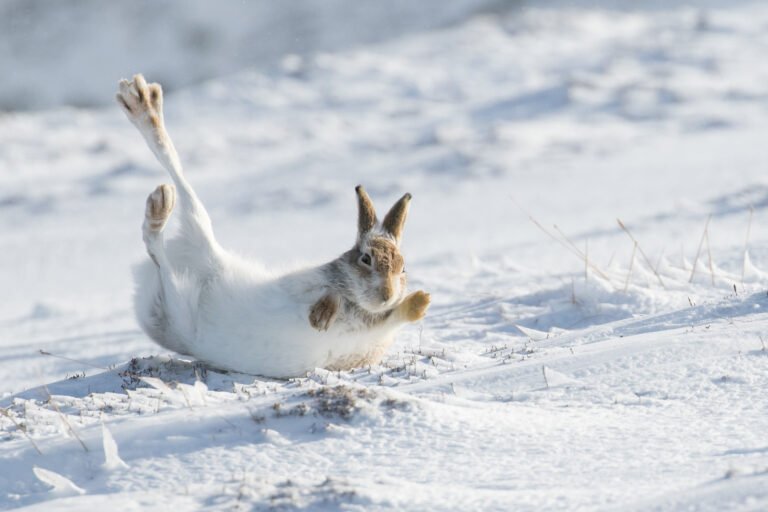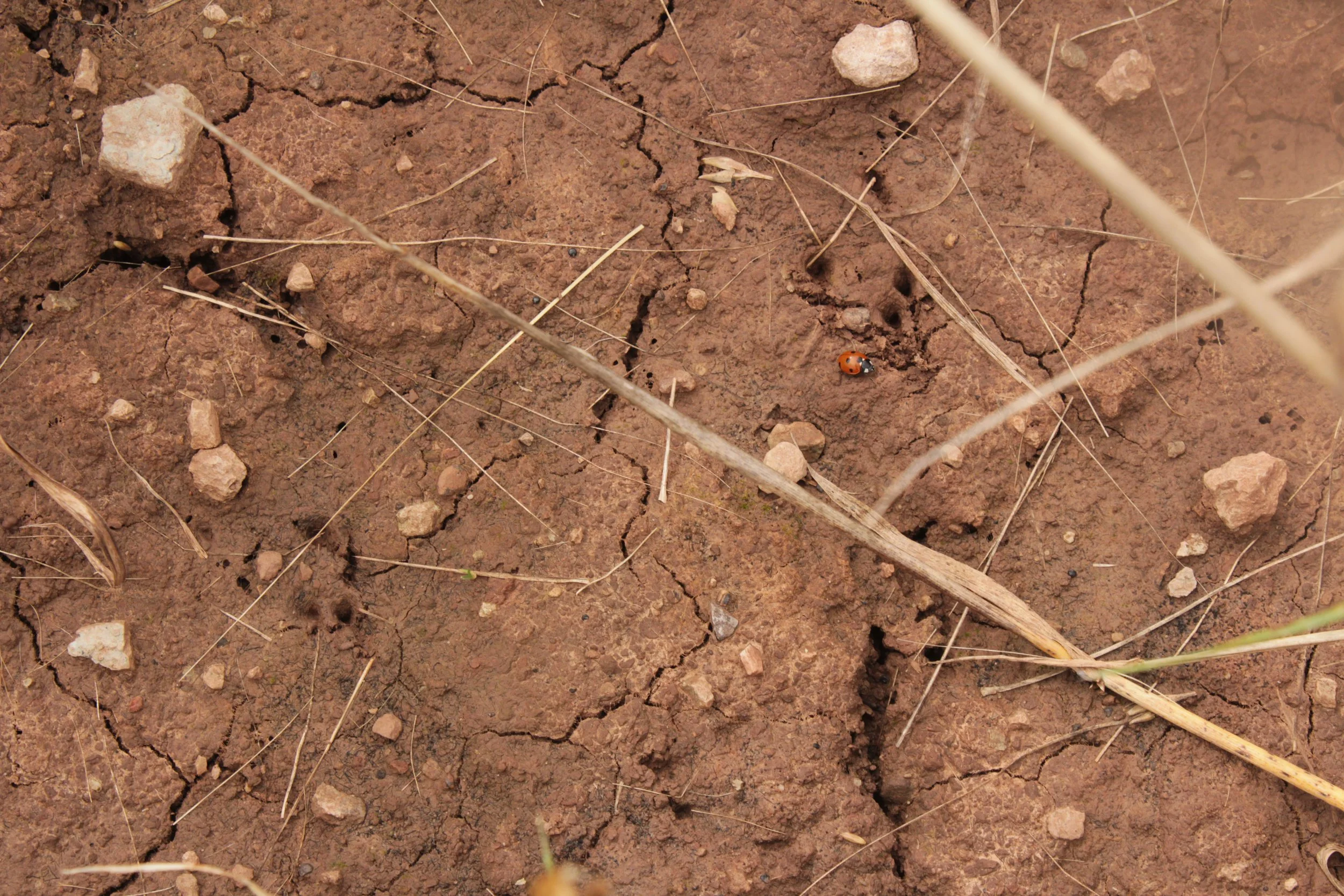Home / British mammals / Mountain hare
Mountain hare
Scientific name: Lepus timidus / Lepus timidus hibernicus
“...the mountain grass; Cannot keep the form; Where the mountain hare has lain.”
The mountain hare is native to mainland Britain and Ireland and has been introduced to islands including Mull. Also known as blue hares, white hares or snow hares, due to their coat turning white in winter, mountain hares are our only native hares.
Taxonomy chart
Animalia - Chordata - Mammalia - Lagomorph - Leporidae - Lepus - L. timidus, OR
Animalia – Chordata – Mammalia – Lagomorpha – Leporidae – Lepus - L. timidus hibernicus (Irish mountain hare)
Conservation status: UK Red List
GB: Near Threatened
England: N/A
Scotland: Near Threatened
Wales: N/A
Global: Least Concern
Summary
Diet: Herbivore. Heather, grasses, rushes, and sedge species.
Habitat: Heather moorlands, generally above 300-400m.
Size: Weight: 2.5-3.5kg and Size: 45-55cm in Scotland, 52-56cm in Ireland.
Lifecycle: Live up to 12 years, on average 3-4. Males mature each year before females. Breed from late January onwards, having 1-4 litters a year of 1-3 offspring each.
Conservation concerns: Numbers are declining where favourable habitat such as former grouse moors have been afforested or heather has been removed.
Geography
In the British Isles, most mountain hares are found in Scotland and Ireland, specifically where they are native in the Highlands of Scotland, but also where they have been introduced to the Southern Uplands and on some Scottish Islands including Hoy (Orkney), Mainland (Shetland), Mull and Skye. They are also present in the Peak District where they were introduced in the late 1800’s. In Ireland, mountain hares are genetically distinct, and are called the Irish hare or Lepus timidus hibernicus.
Elsewhere, mountain hares favour boreal forest, but in Britain, they prefer heather moorlands; particularly those that are managed by burning in strips for red grouse. They are generally found above 300-400m, though can be found on moorlands where they are just above sea-level, for example in north-west Scotland. They are also found in grassland and on rocky hilltops.
Biology
Mountain hares can grow to around 45-55cm in Scotland and 52-56cm in Ireland. They weigh approximately 2.5 – 3.5kg, and females are slightly heavier than males.
Sporting a white tail, mountain hares have a coat which is brown in summer but turns white in winter. Their fur changes colour depending on temperature, so not all individuals will always turn completely white. Due to climate change, snowfall is decreasing every year, meaning this adaptation is becoming increasingly a hindrance. They have long ears that are shorter than those of the brown hare with slightly black tips.
Mountain hares can live up to 12 years in the wild, but on average they live only 3-4. After their birth year, mountain hares become sexually mature, though males generally mature before females, and mating takes place from the end of January onwards. Female mountain hares gestate for 50 days and mostly give birth in March-July to 1-4 litters of 1-3 offspring a year, but occasionally more. Larger females breed earlier, and females in their first year suffer higher prenatal mortality in their earliest litter. Their reproductive behaviour is similar to that of brown hares, with several males chasing a single female who may rebuff them by boxing. The newly born leverets are fully-furred, have open eyes and receive little parental care other than an evening suckling visit by their mother.
Ecology
Mountain hares are herbivores and mostly eat heather (particularly Calluna vulgaris), sedges, rushes, and grasses – especially in the summer. They occasionally browse woody plants such as dwarf shrubs and trees.
Mountain hare population densities fluctuate periodically, varying at least 10-fold, and reaching a peak approximately every 10 years. They rest during the day in forms and scrapes which provide shelter and sometimes make burrows in the earth or in snow, particularly when they are young. Their runs usually pass directly up slopes, rather than traversing them like those of sheep and deer, and they are most active at night. During periods of snow cover, they gather on leeward hill slopes, in groups of 20+, to shelter or feed where shallow snow permits scraping to reveal underlying heather. Their babies (leverets) are preyed upon by several predators including foxes, stoats, cats, buzzards and eagles; eagles are also major predators of adults.
Conservation
Mountain hares are classified as ‘near threatened’ on the UK Red List across Great Britain overall, as well as in Scotland. They are listed in Annex V of the EC Habitats Directive (1992) as a species ‘of community interest whose taking in the wild and exploitation may be subject to management measures.’ This conservation status means that certain methods of capture are prohibited or restricted. Mountain hares have historically been considered as small game with little commercial value either as a meat source or for shooting revenue.
On some western Scottish moors, mountain hares are now rare where they were previously abundant. Their numbers have declined locally where favourable habitat such as former grouse moors have been afforested or heather has been removed by excessive grazing by other animals. Young forestry plantations can support high densities of hares, which sometimes cause significant damage to trees, but these high densities decline once the forest canopy closes and the ground vegetation is diminished. Brown hares have also displaced mountain hare across large parts of the country.
History
Mountain hares have been present in the UK for a very long time – bones between 114,000 and 131,000 years old have been found in Devon and the Thames Valley.
They appear in folklore across the UK, and especially in Celtic and Pagan stories. In Celtic folklore, for example, hares were often thought of as witches’ familiars. In Scotland specifically, hares were one of only a few animals (alongside deer, cats, and seals) that were associated with shapeshifting, and it was said that it was mostly women who could shapeshift into them. These hare-shifting women were often classified as witches, and it was said that the only way of killing them was to shoot them with a silver bullet whilst they were in the form of a hare.
In Ireland, hares and witches were also closely interlinked. One tale describes a man who shot at a hare in the early morning and followed its trail of blood into a cabin, where he found Nancy Molony, ‘the greatest witch in all the county’, groaning in pain, as she had shapeshifted back from her hare form. In the Welsh Mabinogion, a man called Gwion transformed into a mountain hare to escape the wrath of the witch Ceridwen, but she outsmarted him by turning into a greyhound, amongst other animals, to hunt him down. He finally shifted into a grain of wheat, but Ceridwen turned into a hen to eat him and became pregnant with Taliesin, who grew up to become the legendary Welsh bard.
Outside of their link with witches, mountain hares were also often used in medicinal treatments; their brains were said to relieve headaches, their blood and skin bladder stones, and their gall eye problems.
Although they used to be widespread across the UK, mountain hare ranges now mostly only cover Ireland and parts of Scotland. In the late 1800’s, mountain hares were reintroduced to the Peak District, Derbyshire, Yorkshire, North Wales, the Lake District and Northumberland, but only those translocated to the Peak District survived and are still there today.
Identification and surveying
Footprints: Tracks can be seen well in the snow. When moving, their back paws land in front of the their front paws, so it is easy to tell which direction the hare was travelling.
Surveying period: Year-round. You can survey for mountain hares using our guide and Mammal Mapper App (see recommended reading).
FAQs
-
Yes, mountain hares live across Ireland and are a separate subspecies called Irish hares.
-
Mountain hares eat heather, grasses, rushes, and sedges.
-
Mountain hares turn white in winter, an adaptation that helps them blend in with the background on snowy hillsides and thus protects them from predation. As the slopes are snowclad for less of each year due to climate change, this adaptation is increasingly a hindrance.
-
Mountain hares gestate for 50 days and mostly give birth in March-July to 1-4 litters of 1-3 offspring a year.
-
Mountain hares live an average of 3-4 years but can live up to 10-12.
Recommended readings
Mountain Hare – The Hare Preservation Trust (hare-preservation-trust.com)
The Volunteer Mountain Hare Survey — Mammal Society
Mountain hares in the English Peak District: People's Trust for Endangered Species (ptes.org)
The Mabinogion: Taliesin: Taliesin (sacred-texts.com)
Ancient Legends, Mystic Charms, and Superstitions of Ireland: The Hare (sacred-texts.com)
The Shapeshifting Hares of the Gàidhealtachd | Scotland's Nature (wordpress.com)
Confusion species
Rabbit (Oryctolagus cuniculus)
Rabbits have smaller ears than mountain hares without the black tips that mountain hares do. Rabbits have grey/brown fur year-round whilst mountain hares have pale grey fur in the summer which turns white in the winter. Rabbits are generally smaller than mountain hares and have shorter legs.
Brown hare (Lepus europaeus)
Brown hares have longer ears than mountain hares and black on the tops of their tails, unlike the all-white tails of mountain hares. Brown hares also have amber eyes, whilst mountain hares have brown eyes. Brown hares have brown fur with orange/brown sides year-round, whereas mountain hares have pale grey fur in the summer which turns white in the winter.
Identify tracks
Found some animal tracks but not sure what kind of animal they belong to?
Identify sounds
Heard a curious animal sound but no idea whose making it?
Wildlife identification FAQ
Still not sure what you’ve found? Head over to our FAQ for an answer.










